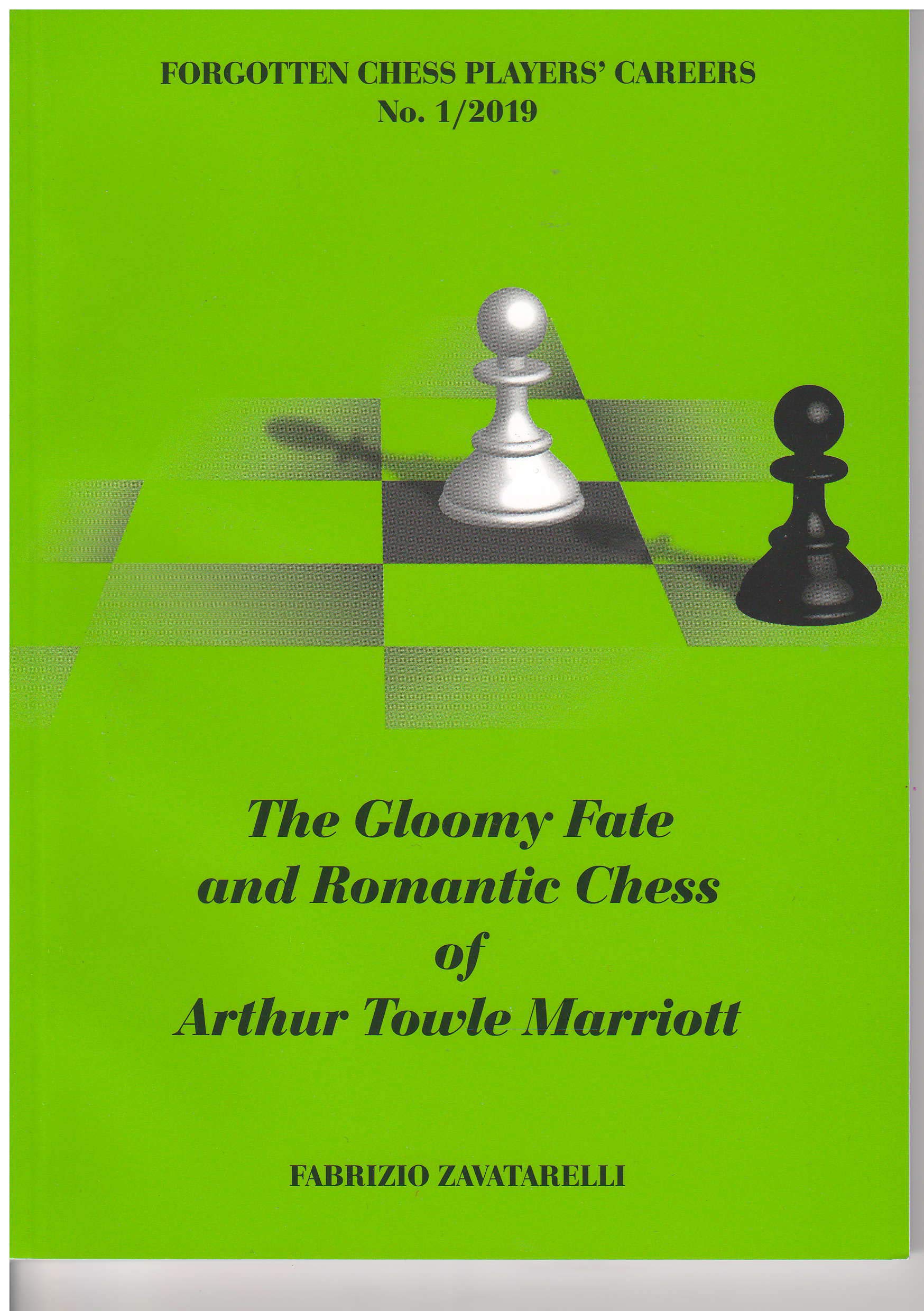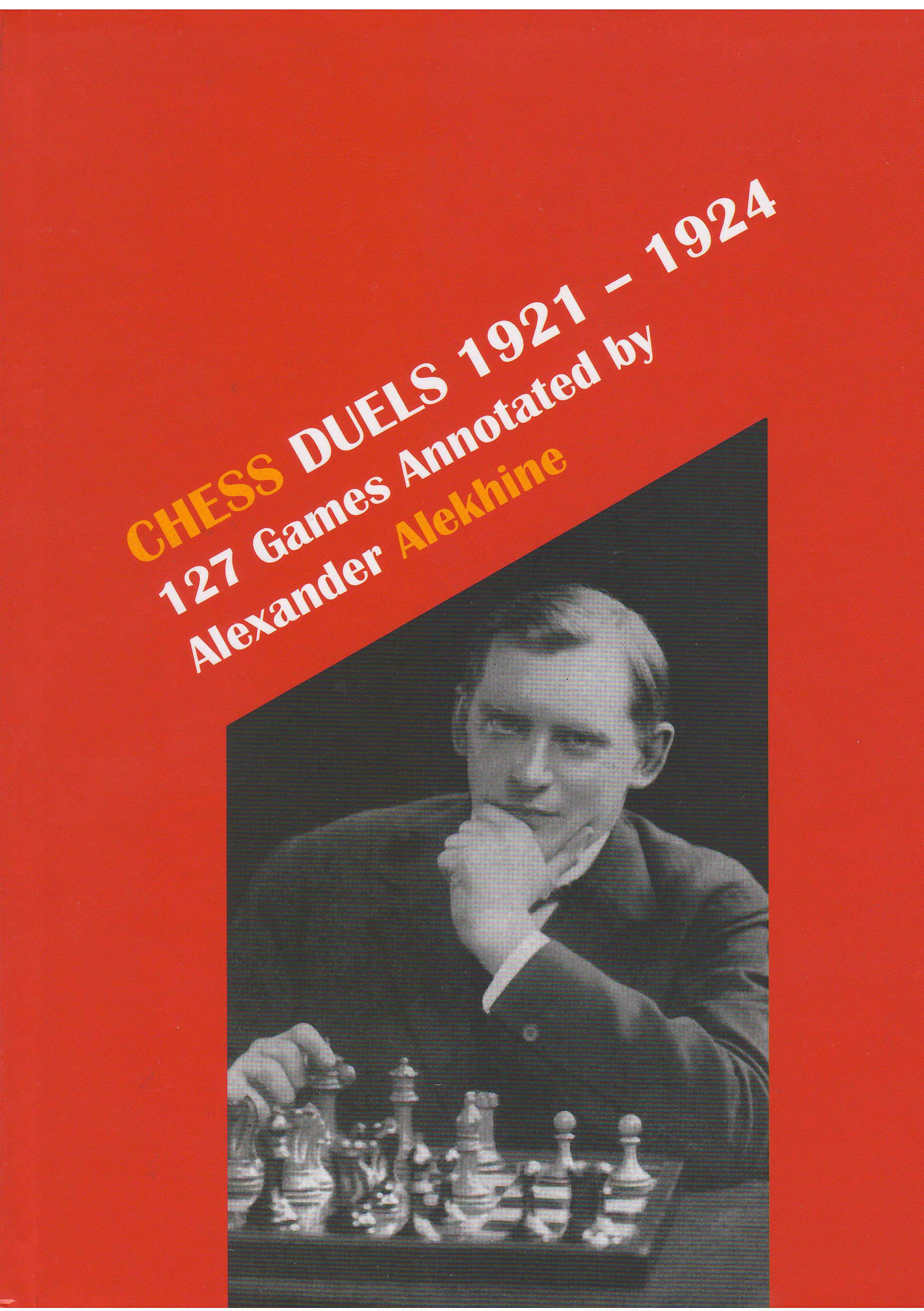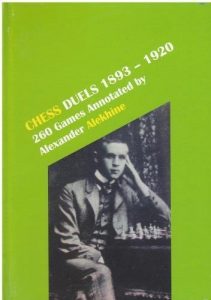The Gloomy Fate and Romantic Chess of Arthur Towle Marriott : Fabrizio Zavatarelli

From the publisher:
Biography of prominent Nottingham chess-player (1859-1884). Biography contents 156 annotated games with comments mostly from contemporary sources. A. T. Marriott played chess with many contemporary chess players of this time, e.g. Blackburne, Freeborough, MacDonnell, Thorold, etc.
I won’t quote the publisher’s introduction, as it’s the same as you’ll find in this book.
This is the first volume in a different series, though, featuring the careers of forgotten chess players. In this case the author is Fabrizio Zavatarelli, an Italian chess historian, who has written a book on Kolisch and co-authored one on Neumann, Hirschfeld and Suhle, both published by McFarland. An author, then, with a proven track record as an excellent writer and researcher in this field. A helpful feature of the book is a rating system for games: one star: of some interest, two stars: worthy of an anthology, and three stars (there are none in this book): a masterpiece.
Arthur who? You may well ask. I hadn’t heard of him until I saw the advance publicity for this book. Arthur Towle Marriott, it turns out, was the youngest and strongest member of a chess playing family. We have 156 games, with contemporary annotations, along with a few problems, and we follow him as he travels the country, playing chess wherever and whenever he can.
Marriott was born in Nottingham on 25 November 1859, the youngest son of Thomas and Sarah. There is information about his family now available online which Zavatarelli was either unable to find or which wasn’t available when he was researching the book. A footnote suggests that Sarah’s maiden name was probably Lacey: it wasn’t: she was Sarah Green. He also states that no mention of the family can be found in the 1861 and 1871 census records: in fact the 1871 record has now been found, but not, as yet, the 1861 record. You can find out more information about the chess playing Marriotts here.
His earliest games, mostly played by correspondence, date from 1876, about the time of his 17th birthday. But a few months later he was playing, and winning, in a match between Nottingham against Leicester. As an example of Marriott’s play at this time, here’s a casual game played at his chess club.
From this game you can tell that he was a highly talented tactician with a love, which would last the rest of his life, of rather dubious gambits.
Marriott played in the 2nd Class Tournament at Grantham over the following New Year, outclassing the opposition to win with a 100% score. In August 1878 he travelled to Hull for a series of games against Edward Freeborough, later to find fame as the co-author of Chess Openings Ancient and Modern. Two months later, Blackburne was in town for a simul, and, underestimating his young opponent, was mated in only 17 moves.
We follow Marriott’s career and travels over the next few years, visiting London, for example, to take on the chess automaton ‘Mephisto’, possibly operated by Gunsberg at the time. But at some point, possibly early 1881, he contracted tuberculosis. Undeterred, he continued playing chess between bouts of his illness.
Everyone loves a good king hunt, so take a look at this.
Curiously, the moves up to 15. Be3 were duplicated in a 21st century game (Haller – Torretta Wasselonne Open 2009), but White ended up repeating moves in a winning position.
The Danish Gambit was one of Marriott’s favourite openings, as was the Boden-Kieseritzky Gambit, which he also played with colours reversed: yes – the currently fashionable (in some circles) Stafford Gambit.
It’s very clear from the games in this book that Arthur Towle Marriott was a player with an outstanding tactical imagination: deadly against opponents who failed to develop their pieces in the opening. Not everything stands up to computer analysis, but he was more interested in playing a beautiful game than winning prosaically.
Playing in a tournament against master standard opposition, though, is another matter entirely. Would he be able to raise his game and become a world class player like Blackburne, or would he remain just a tricky tactician like Bird?
A tournament in Birmingham in August 1883 gave him the chance to find out by taking on some of the country’s leading amateurs under serious match play conditions.
In the first round he faced Nelson Fedden, and this time forsook his beloved gambits for a more cautious start.
This game suggested that he could make the grade, but, had he been in full health he would no doubt have concluded more quickly and efficiently rather than missing some simple mates. He lost to Thorold, the eventual winner, in the second round, and then, playing poorly, to Ranken. At that point he was forced to withdraw from the tournament on health grounds. In November he travelled down to Bournemouth, hoping the sea air would improve his health, and, of course, played a lot of chess while he was there. He returned home in early 1884, but his condition was worsening and he spent some time in the TB Sanatorium at Ventnor on the Isle of Wight. It was all to no avail, though, and that dreadful disease claimed his life on the night of 21-22 November, just a few days before his 25th birthday.
Here’s a problem: White to play and mate in 3 moves (Nottingham Guardian 1884). You’ll find the solution at the end of this review.
Arthur Towle Marriott is one of the great might-have-beens of English chess history. He was a highly creative and imaginative attacking player who was very much at home in the 19th century world of romantic gambit play. A real chess enthusiast, he played wherever he went: casual games, club matches or tournaments, simultaneous displays, odds games, blindfold games, they all came alike to him. You’ll even find a game of four-handed chess here. He was very popular as well: everyone who knew him soon became fond of him, and you’ll also find a few lovely anecdotes within these pages. But he was strong enough to beat the likes of Blackburne and Gunsberg in one-to-one games. EdoChess gives him a peak rating of 2376 in 1881, placing him 66th in the world. It’s quite possible that, had he lived, he’d have reached grandmaster level.
What you get is everything currently known about Marriott’s life and chess. What you don’t get is external contextualisation: there’s a lot more to be told about his family background, some of which I’ll endeavour to do at a future date in my Minor Pieces series. There’s much that could be written about some of his opponents, who also have their stories. You also don’t get computer-assisted analysis: he played some highly complex games, and, inevitably, many of the annotations fail to meet with Stockfish’s approval. Finally, you don’t get professional production values. The publisher uses a different – and less suitable – diagram font than in the Mackenzie book: it’s not always easy to distinguish between some of the white and black pieces.
One of my particular interests is in the history of chess in Leicester (a city with which I have various personal connections), and Marriott played in several matches between his and my father’s home towns. If you’re interested in chess at this time and place you’ll be sure to want this book. If you have a general interest in 19th century chess history, if you love the romantic 19th century style of play, where gambits are offered and accepted, and where pieces are sacrificed for speculative attacks, you won’t be disappointed by the specimens here. If you just want to find out about an unjustly forgotten figure in chess history, one who, in some ways, typified the spirit of his age, again, go right ahead and buy it.
Problem solution: 1. Ng3 d4 2. Nh3 Ke3 3. Rc3#. The two knights withdraw to set up a pin mate. Not profound, but rather charming, I think.
Richard James, Twickenham 27th May 2021

Book Details :
- Softback : 160 pages
- Publisher: Publishing House Moravian Chess (1 Jan. 2019)
- Language: English
- ISBN-10:8071890162
- ISBN-13:978-8071890164
Official web site of Moravian Chess






